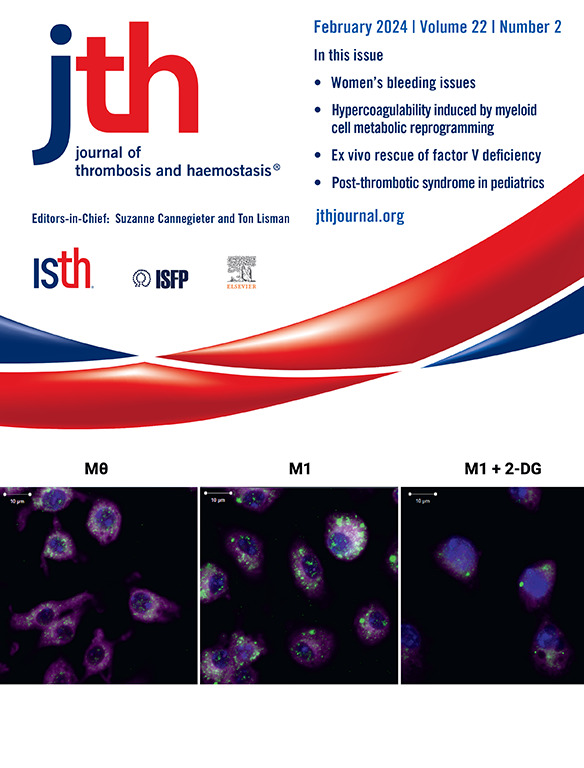Mathematical analysis of emicizumab: affinity-driven complex formation and lipid-surface reactions
IF 5
2区 医学
Q1 HEMATOLOGY
引用次数: 0
Abstract
Background
Emicizumab is a bispecific antibody that binds activated factor (F)IXa with 1-arm and FX with the other. Binding bridges FIXa and FX, replacing the function of FVIII in hemophilia A. Unlike FVIII, emicizumab does not bind directly to lipid surfaces.
Objectives
This study aimed to investigate emicizumab’s lipid-surface dependent mechanisms through mathematical modeling and biochemical assays.
Methods
We expanded our mathematical model of tissue factor (TF):VIIa activation of FX to incorporate emicizumab and FIXa interactions. We calibrated our model using experimental data.
Results
High concentrations of emicizumab inhibit FX activation by TF:VIIa. Our mathematical model explains these observations only when FX bound to emicizumab is partially restricted from binding to lipid surfaces and to TF:VIIa. Lipid enhances FX activation of FIXa in the presence of emicizumab. In our 2-arm interaction model, we estimated kinetic rates for emicizumab-dependent activation of FX on the lipid surface. The model successfully predicted FIXa activation of FX with and without emicizumab across many experimental conditions. Ternary complexes (FIXa, FX, and emicizumab) in solution decreased when lipid increased while ternary complexes on lipid increased. Sensitivity analysis, which varied lipid, dissociation constants, and catalytic rates, highlighted the impact of binding-arm affinity on reaction velocities.
Conclusion
High concentrations of emicizumab decrease TF:VIIa activation of FX by reducing FX binding to both the lipid surface and TF:VIIa. Emicizumab enhances FIXa activation of FX on the lipid surface by preferentially binding to lipid-bound FX and subsequently to lipid-bound FIXa with an enhanced association rate due to colocalization on the lipid surface.
emicizumab的数学分析:亲和驱动的复合物形成和脂质表面反应。
背景:Emicizumab是一种双特异性抗体,单臂结合活化因子IX (FIXa),另臂结合因子X (FX)。结合桥接FIXa和FX,取代因子VIII在血友病a中的功能。与FVIII不同,emicizumab不直接结合脂质表面。目的:通过数学建模和生化分析探讨emicizumab的脂质表面依赖机制。方法:我们扩展了TF: via激活FX的数学模型,纳入了emicizumab和FIXa的相互作用。我们用实验数据校准了我们的模型。结果:高浓度emicizumab可抑制TF:VIIa对FX的激活。我们的数学模型仅在结合emicizumab的FX部分限制与脂质表面和TF:VIIa结合时解释了这些观察结果。在emicizumab存在下,脂质增强FIXa的FX激活。在我们的双臂相互作用模型中,我们估计了半曲单抗依赖性的FX在脂质表面激活的动力学速率。该模型在许多实验条件下成功预测了使用或不使用emicizumab的FX的FIXa激活。当脂质增加时,溶液中的三元配合物(FIXa, FX和emicizumab)减少,而脂质上的三元配合物增加。敏感性分析,包括改变脂质、解离常数和催化速率,突出了结合臂亲和力对反应速度的影响。结论:高浓度的emicizumab通过减少FX与脂质表面和TF:VIIa的结合来降低TF:VIIa对FX的激活。Emicizumab通过优先结合脂质结合的FX和随后结合脂质结合的FIXa来增强FX在脂质表面的FIXa激活,由于脂质表面的共定位,结合率提高。
本文章由计算机程序翻译,如有差异,请以英文原文为准。
求助全文
约1分钟内获得全文
求助全文
来源期刊
CiteScore
24.30
自引率
3.80%
发文量
321
审稿时长
1 months
期刊介绍:
The Journal of Thrombosis and Haemostasis (JTH) serves as the official journal of the International Society on Thrombosis and Haemostasis. It is dedicated to advancing science related to thrombosis, bleeding disorders, and vascular biology through the dissemination and exchange of information and ideas within the global research community.
Types of Publications:
The journal publishes a variety of content, including:
Original research reports
State-of-the-art reviews
Brief reports
Case reports
Invited commentaries on publications in the Journal
Forum articles
Correspondence
Announcements
Scope of Contributions:
Editors invite contributions from both fundamental and clinical domains. These include:
Basic manuscripts on blood coagulation and fibrinolysis
Studies on proteins and reactions related to thrombosis and haemostasis
Research on blood platelets and their interactions with other biological systems, such as the vessel wall, blood cells, and invading organisms
Clinical manuscripts covering various topics including venous thrombosis, arterial disease, hemophilia, bleeding disorders, and platelet diseases
Clinical manuscripts may encompass etiology, diagnostics, prognosis, prevention, and treatment strategies.

 求助内容:
求助内容: 应助结果提醒方式:
应助结果提醒方式:


